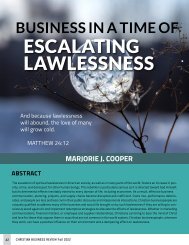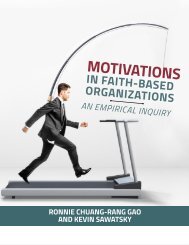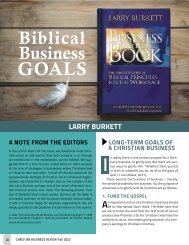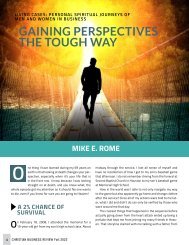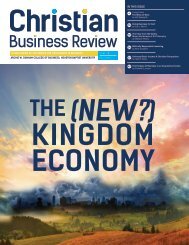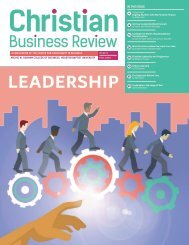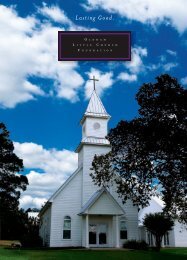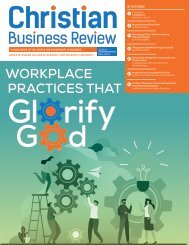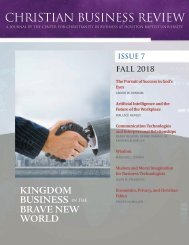Christian Business Review 2022: Pressing On Toward God's Goal
You also want an ePaper? Increase the reach of your titles
YUMPU automatically turns print PDFs into web optimized ePapers that Google loves.
MOTIVATIONS IN FAITH-BASED ORGANIZATIONS<br />
CBR PEER-REVIEWED ARTICLES<br />
METHODOLOGY<br />
RESPONDENTS AND PROCEDURE<br />
We tested the six hypotheses in a cross-sectional online<br />
survey in four <strong>Christian</strong> colleges in Canada, using an internet-based<br />
survey. All four are attached to a religious organization<br />
or tradition, have strong statements of faith and<br />
deeply embed faith in their operational structure, meeting<br />
Torry’s FBO definition. 10 The link to the survey was sent to<br />
faculty and staff in each university, after permission from<br />
management. The respondents were informed that the purpose<br />
of the survey was to examine various motivational<br />
factors in FBOs. We added two screening questions to ensure<br />
that only faculty and staff (not administrators) would<br />
be included in the survey and that only employees who had<br />
been working at the university continuously for at least two<br />
years would be included (recognizing that it may take time<br />
for the three motivating factors to have an effect on job satisfaction).<br />
Questions in the survey included measures of job<br />
satisfaction, personal faith, perceived fit between personal<br />
and organizational faith, TL, motivation, demographics, and<br />
job-related questions (i.e., age, gender, education level, and<br />
years in the organization). 36<br />
Three hundred and five respondents attempted to participate,<br />
resulting in a response rate of 43.70% (cumulatively,<br />
the four universities have 698 employees). 37 We removed 98<br />
responses because of either the two noted restrictions or<br />
missing data. We eliminated two more responses because<br />
of unengaging behaviors (too short a time to complete the<br />
survey). As a result, the final sample size was 205. As some<br />
questions asked respondents to evaluate the transformational<br />
leadership of their immediate supervisors, we anticipated<br />
there would be some unwillingness to provide accurate<br />
answers out of a concern that data would be disclosed.<br />
To overcome this possible response bias, we purposely did<br />
not ask respondents to identify their university, in addition<br />
to providing confidentiality guarantees. We were then unable<br />
to compare response patterns across the universities as well<br />
as leaving university management unexamined as an exogenous<br />
variable; however, the discrepancies in responses are<br />
likely to be low because of similar mission and organizational<br />
faith. A random drawing for three gift cards was offered as an<br />
incentive to participate. Table 1 provides the sample profile.<br />
MEASURES<br />
There are various schools of transformational leadership.<br />
For example, Anthony and Schwartz identify five characteristics<br />
of transformational leaders (e.g., they tend to be<br />
“insider outsiders”, and use cultural change to drive engagement).<br />
38 Lancefield and Rangen describe four actions that<br />
transformational leaders often take (e.g., sharing leadership<br />
more systematically, and making empowerment live up<br />
to its promise). 39 In this research, we adopted the 15-item<br />
seven-point scale to measure transformational leadership<br />
from Bass and Avolio’s Multifactor Leadership Questionnaire,<br />
40 including four, four, three, and four items for idealized<br />
influence, inspirational motivation, intellectual stimulation,<br />
and individualized consideration, respectively. The fit indexes<br />
for the four first-order factors plus one second-order factor<br />
fell within an acceptable range (χ 2 (86) = 240.31, p < .001;<br />
comparative fit index [CFI] = .95; Tucker–Lewis index [TLI]<br />
= .94; root mean square error of approximation [RMSEA] =<br />
.09 (slightly higher than the .08 cutoff value); standardized<br />
root mean square residual [SRMR] = .04), suggesting that<br />
the dimensions we used reflected the transformational<br />
leadership construct. Based on the definitions of expectancy,<br />
instrumentality, and valence, we developed four, four, and<br />
three measurement items to measure the three concepts,<br />
respectively. We dropped one item each for expectancy and<br />
instrumentality due to low factor loadings, which resulted<br />
in a nine-item seven-point scale to measure motivation,<br />
including three items each for expectancy, instrumentality,<br />
and valence. The fit indexes for the three first-order factors<br />
plus one second-order factor fell within an acceptable range<br />
(χ 2 (24) = 65.13, p < .001; CFI = .98; TLI = .97; RMSEA = .09<br />
(slightly higher than the .08 cutoff value); SRMR = .06); thus,<br />
the dimensions we used reflected the motivation construct.<br />
We used a four-item seven-point scale to measure personal<br />
faith, adapted from the Spiritual Transcendence Index. 41 We<br />
drafted four measurement items based on the definition of<br />
perceived fit between personal and organizational faith. We<br />
dropped one item with low factor loading, which resulted<br />
in a three-item seven-point scale to measure perceived fit.<br />
We measured job satisfaction with a three-item seven-point<br />
scale adapted from the satisfaction with overall job scale. 42<br />
All variables had good Cronbach’s alpha values. All constructs<br />
demonstrated convergent and discriminant validity. Average<br />
CHRISTIAN BUSINESS REVIEW Fall <strong>2022</strong> 292





